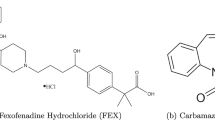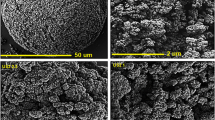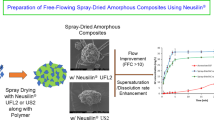Abstract
Different pharmaceutical manufacturing processes have been demonstrated to represent feasible platforms for the production of pharmaceutical cocrystals. However, new methods are needed for the manufacture of cocrystals on a large scale. In this work, the suitability of the use of a fluidized bed system for granulation and concomitant cocrystallization was investigated. Dapsone (DAP) and caffeine (CAF) have been shown to form a stable cocrystal by simple solvent evaporation. DAP is the active pharmaceutical ingredient (API) and CAF is the coformer. In the present study, DAP-CAF cocrystals were produced through liquid-assisted milling and the product obtained was used as a cocrystal reference. The granulation of DAP and CAF was carried out using four different experimental conditions. The solid-state properties of the constituents of the granules were characterised by differential scanning calorimetry (DSC) and x-ray powder diffraction (PXRD) analysis while the granule size distribution and morphology were investigated using laser diffraction and scanning electron microscopy (SEM), respectively. DAP-CAF cocrystal granules were successfully produced during fluidized bed granulation. The formation of cocrystals was possible only when the DAP and CAF were dissolved in the liquid phase and sprayed over the fluidized solid particles. Furthermore, the presence of polymers in solution interferes with the cocrystallization, resulting in the amorphization of the DAP and CAF. Cocrystallization via fluidized bed granulation represents a useful tool and a feasible alternative technique for the large scale manufacture of pharmaceutical cocrystals for solid dosage forms.








Similar content being viewed by others
Abbreviations
- DAP:
-
Dapsone
- CAF:
-
Caffeine
- API:
-
Active pharmaceutical ingredient
- DSC:
-
Differential scanning calorimetry
- PXRD:
-
Powder x-ray diffraction
- SEM:
-
Scanning electron microscopy
- BCS:
-
Biopharmaceutics Classification System
- FBG:
-
Fluidized bed granulation
- MCC:
-
Microcrystalline cellulose
- PVP:
-
Polyvinylpyrrolidone
- HPMC:
-
Hydroxypropyl methylcellulose
- EXP:
-
Experimental conditions
- SI:
-
Stability index
- FRI:
-
Flow rate index
- AIF:
-
Angle of internal friction
- ffc:
-
Flow function coefficient
- CBD:
-
Conditioned bulk density
References
Otsuka M, Hasegawa H, Matsuda Y. Effect of polymorphic forms of bulk powders on pharmaceutical properties of carbamazepine granules. Chem Pharm Bull. 1999;47(6):852–6.
Airaksinen S, Karjalainen M, Räsänen E, Rantanen J, Yliruusi J. Comparison of the effects of two drying methods on polymorphism of theophylline. Int J Pharm. 2004;276(1–2):129–41.
Panchagnula R, Sundaramurthy P, Pillai O, Agrawal S, Raj YA. Solid-state characterization of mefenamic acid. J Pharm Sci. 2004;93(4):1019–29.
Chieng N, Zujovic Z, Bowmaker G, Rades T, Saville D. Effect of milling conditions on the solid-state conversion of ranitidine hydrochloride form 1. Int J Pharm. 2006;327(1–2):36–44.
Liu X, Lu M, Guo Z, Huang L, Feng X, Wu C. Improving the chemical stability of amorphous solid dispersion with cocrystal technique by hot melt extrusion. Pharm Res. 2012;29(3):806–17.
Food and Drug Administration. Guidance for industry: waiver of in vivo bioavailability and bioequivalence studies for immediate-release solid oral dosage forms based on a biopharmaceutics classification system. Rockville: Food and Drug Administration; 2000.
Aguiar AJ, Krc J, Kinkel AW, Samyn JC. Effect of polymorphism on the absorption of chloramphenicol from chloramphenicol palmitate. J Pharm Sci. 1967;56(7):847–53.
Bauer J, Spanton S, Henry R, Quick J, Dziki W, Porter W, et al. Ritonavir: an extraordinary example of conformational polymorphism. Pharm Res. 2001;18(6):859–66.
Sun C, Grant DJ. Influence of crystal structure on the tableting properties of sulfamerazine polymorphs. Pharm Res. 2001;18(3):274–80.
Amidon GL, Lennernäs H, Shah VP, Crison JR. A theoretical basis for a biopharmaceutic drug classification: the correlation of in vitro drug product dissolution and in vivo bioavailability. Pharm Res. 1995;12(3):413–20.
Kalepu S, Nekkanti V. Insoluble drug delivery strategies: review of recent advances and business prospects. Acta Pharm Sin B. 2015;5(5):442–53.
Leuner C, Dressman J. Improving drug solubility for oral delivery using solid dispersions. Eur J Pharm Biopharm. 2000;50(1):47–60.
Babu NJ, Nangia A. Solubility advantage of amorphous drugs and pharmaceutical cocrystals. Cryst Growth Des. 2011;11(7):2662–79.
Blagden N, de Matas M, Gavan PT, York P. Crystal engineering of active pharmaceutical ingredients to improve solubility and dissolution rates. Adv Drug Deliv Rev. 2007;59(7):617–30.
Lee KS, Kim KJ, Ulrich J. In situ monitoring of cocrystallization of salicylic acid–4, 4′-dipyridyl in solution using Raman spectroscopy. Cryst Growth Des. 2014;14(6):2893–9.
Liu M, Hong C, Yao Y, Shen H, Ji G, Li G, et al. Development of a pharmaceutical cocrystal with solution crystallization technology: preparation, characterization, and evaluation of myricetin-proline cocrystals. Eur J Pharm Biopharm. 2016;107:151–9.
Chieng N, Hubert M, Saville D, Rades T, Aaltonen J. Formation kinetics and stability of carbamazepine−nicotinamide cocrystals prepared by mechanical activation. Cryst Growth Des. 2009;9(5):2377–86.
Bysouth SR, Bis JA, Igo D. Cocrystallization via planetary milling: enhancing throughput of solid-state screening methods. Int J Pharm. 2011;411(1–2):169–71.
Dhumal RS, Kelly AL, York P, Coates PD, Paradkar A. Cocrystalization and simultaneous agglomeration using hot melt extrusion. Pharm Res. 2010;27(12):2725–33.
Moradiya HG, Islam MT, Halsey S, Maniruzzaman M, Chowdhry BZ, Snowden MJ, et al. Continuous cocrystallisation of carbamazepine and trans-cinnamic acid via melt extrusion processing. Cryst Eng Comm. 2014;16(17):3573–83.
Alhalaweh A, Velaga SP. Formation of cocrystals from stoichiometric solutions of incongruently saturating systems by spray drying. Cryst Growth Des. 2010;10(8):3302–5.
Serrano DR, O’Connell P, Paluch KJ, Walsh D, Healy AM. Cocrystal habit engineering to improve drug dissolution and alter derived powder properties. J Pharm Pharmacol. 2016;68(5):665–77.
Waldie B. Growth mechanism and the dependence of granule size on drop size in fluidized-bed granulation. Chem Eng Sci. 1991;46(11):2781–5.
Davis TD, Morris KR, Huang H, Peck GE, Stowell JG, Eisenhauer BJ, et al. In situ monitoring of wet granulation using online x-ray powder diffraction. Pharm Res. 2003;20(11):1851–7.
Potter CB, Kollamaram G, Zeglinski J, Whitaker DA, Croker DM, Walker GM. Investigation of polymorphic transitions of piracetam induced during wet granulation. Eur J Pharm Biopharm. 2017;119:36–46.
Davis TD, Peck GE, Stowell JG, Morris KR, Byrn SR. Modeling and monitoring of polymorphic transformations during the drying phase of wet granulation. Pharm Res. 2004;21(5):860–6.
do Amaral LH, do Carmo FA, Amaro MI, de Sousa VP, da Silva LC, de Almeida GS, et al. Development and characterization of dapsone cocrystal prepared by scalable production methods. AAPS PharmSciTech. 2018;19(6):2687–99.
Jiang L, Huang Y, Zhang Q, He H, Xu Y, Mei X. Preparation and solid-state characterization of dapsone drug–drug co-crystals. Cryst Growth Des. 2014;14(9):4562–73.
Freeman R. Measuring the flow properties of consolidated, conditioned and aerated powders—a comparative study using a powder rheometer and a rotational shear cell. Powder Technol. 2007;174(1–2):25–33.
Newman A, Zografi G. Critical considerations for the qualitative and quantitative determination of process-induced disorder in crystalline solids. J Pharm Sci. 2014;103(9):2595–604.
Morris KR, Griesser UJ, Eckhardt CJ, Stowell JG. Theoretical approaches to physical transformations of active pharmaceutical ingredients during manufacturing processes. Adv Drug Deliv Rev. 2001;48(1):91–114.
Zhang GG, Law D, Schmitt EA, Qiu Y. Phase transformation considerations during process development and manufacture of solid oral dosage forms. Adv Drug Deliv Rev. 2004;56(3):371–90.
Seefeldt K, Miller J, Alvarez-Nunez F, Rodriguez-Hornedo N. Crystallization pathways and kinetics of carbamazepine–nicotinamide cocrystals from the amorphous state by in situ thermomicroscopy, spectroscopy, and calorimetry studies. J Pharm Sci. 2007;96(5):1147–58.
Friščić T. Supramolecular concepts and new techniques in mechanochemistry: cocrystals, cages, rotaxanes, open metal–organic frameworks. Chem Soc Rev. 2012;41(9):3493–510.
Davies WL, Gloor WT. Batch production of pharmaceutical granulations in a fluidized bed I: effects of process variables on physical properties of final granulation. J Pharm Sci. 1971;60(12):1869–74.
Schaefer T, Worts O. Control of fluidized bed granulation. I. Effects of spray angle, nozzle height and starting materials on granule size and size distribution. Arch Pharm Chem Sci. 1977;5:51–60.
Schaafsma SH, Vonk P, Segers P, Kossen NW. Description of agglomerate growth. Powder Technol. 1998;97(3):183–90.
Schaafsma SH, Vonk P, Kossen NW. Fluid bed agglomeration with a narrow droplet size distribution. Int J Pharm. 2000;193(2):175–87.
Alkan H, Ulusoy A. Granulation in a fluidized bed. I. Effect of addition of the binder in solution or in dry form. DOGA TU J Med Pharm. 1987;11(1):1–7.
D'alonzo GD, O'connor RE, Schwartz JB. Effect of binder concentration and method of addition on granule growth in a high intensity mixer. Drug Dev Ind Pharm. 1990;16(12):1931–44.
Wells JI, Walker CV. The influence of granulating fluids upon granule and tablet properties: the role of secondary binding. Int J Pharm. 1983;15(1):97–111.
Dias VH, Pinto JF. Identification of the most relevant factors that affect and reflect the quality of granules by application of canonical and cluster analysis. J Pharm Sci. 2002;91(1):273–81.
Sastry KV, Fuerstenau DW. Mechanisms of agglomerate growth in green pelletization. Powder Technol. 1973;7(2):97–105.
Vora C, Patadia R, Mittal K, Mashru R. Preparation and characterization of dipyridamole solid dispersions for stabilization of supersaturation: effect of precipitation inhibitors type and molecular weight. Pharm Dev Technol. 2016;21(7):847–55.
Ho HO, Su HL, Tsai T, Sheu MT. The preparation and characterization of solid dispersions on pellets using a fluidized-bed system. Int J Pharm. 1996;139(1–2):223–9.
Zhou Q, Armstrong B, Larson I, Stewart PJ, Morton DA. Improving powder flow properties of a cohesive lactose monohydrate powder by intensive mechanical dry coating. J Pharm Sci. 2010;99(2):969–81.
Funding
This publication has emanated from research supported in part by a research grant from Science Foundation Ireland (SFI) and is co-funded under the European Regional Development Fund under Grant Number 12/RC/2275.
Author information
Authors and Affiliations
Corresponding author
Additional information
Publisher’s note
Springer Nature remains neutral with regard to jurisdictional claims in published maps and institutional affiliations.
Rights and permissions
About this article
Cite this article
Todaro, V., Worku, Z.A., Cabral, L.M. et al. In Situ Cocrystallization of Dapsone and Caffeine during Fluidized Bed Granulation Processing. AAPS PharmSciTech 20, 28 (2019). https://doi.org/10.1208/s12249-018-1228-4
Received:
Accepted:
Published:
DOI: https://doi.org/10.1208/s12249-018-1228-4




